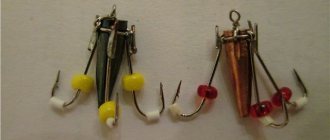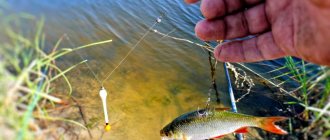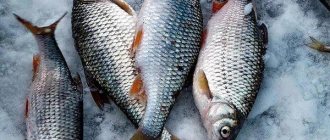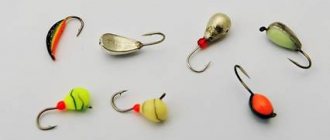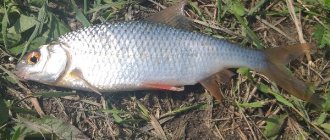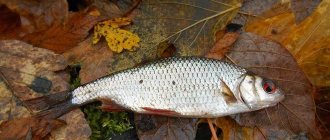“Cow” bait
Recently, when visiting a fishing store, I was amused by the advertisement posted on the entrance doors. It confidentially reported that, in addition to live capsicum, crucian carp and sprat of the first frost, “dyed udder” was available for sale. On the doors of another store there was also a sheet with a list of baits available for sale: bloodworms, maggots, worms, etc. cow's udder at a price of 20 rubles per serving.
This bait - pieces of cow udder - became known and quickly gained popularity among winter fishermen relatively recently: five to seven years ago. But the fact that recently they have begun to sell it in stores along with such traditional baits as bloodworms and maggots speaks volumes about the demand for cow udders for winter fishing.
I first learned about using pieces of cow udder as bait from experienced fisherman Anatoly Gennadievich Bantikov, at whose invitation I had to go to the “secret” lake for roach. When I asked him what baits I should stock up on for successful fishing and first of all mentioned bloodworms, he skeptically noted that just in case, you can take a “raspberry” with you, but he himself has recently completely refused to use bloodworms, preferring pieces of cow's udder to it.
This bait is a rather dense and fibrous meat of a yellowish-pink color. I don’t know what color the cunning sellers thought of painting it, but having some experience in using this bait, I can say that a cow’s udder of a “natural” color and without additional coloring is very attractive to fish.
The undoubted and probably biggest advantage of using a cow's udder in winter is that a piece of it holds very firmly on the hook, and even with active biting, the fish cannot pull it off with impunity. It is enough to place a small piece of udder on the jig hook at the beginning of fishing and you can be sure that it will last until the end of fishing. For the nozzle, you need to use pieces slightly smaller than a match head. When in water, the fibrous meat quickly swells, increasing in size, and the more bites there are on it, the better: this will cause the piece to very quickly become disheveled, becoming like an appetizing multi-legged insect, and will be even more attractive to fish.
So when fishing with a cow's udder, there is no need to constantly update the bait on the hook, which becomes especially important when fishing in frosty and windy weather. And if after fishing you do not remove a piece of cow udder from the hook, and at the same time store the fishing rod in a cold room, on your next fishing trip the frozen or dried bait, when lowered into the water, will quickly soften and completely restore its properties. Therefore, if desired, just one piece of cow udder can be “stretched” over several fishing trips!
A cow's udder costs mere pennies if you buy it in the meat aisles at the market, and for just a few tens of rubles you can become the owner of a hefty piece of excellent and catchable bait, which is more than enough for the entire ice fishing season. In general, even with regular fishing on a cow’s udder, a piece only the size of a matchbox will be enough for the entire winter.
True, a couple of years ago, when at the very beginning of winter I was going to buy a cow's udder for future use, the sellers of the meat aisles just shrugged helplessly, saying that the udder was on sale, but in just a few days it was sold out. The traders themselves were surprised at the sudden popularity of this offal among buyers, not even realizing that they were not buying udders from them to feed their pets.
It is necessary to store the udder in the freezer, cutting pieces of the required size with a sharp knife before fishing.
Any “white” fish responds well to this bait. By the end of that fishing trip, where we had to fish with the udder for the first time, our catch included roach, rudd, silver bream, and bream. Anatoly Gennadievich even caught two good roaches (this was in mid-February on a floodplain lake!), and I caught a small pike on a jig baited with a piece of a cow’s udder, but miraculously it didn’t bite through the cobweb line.
In general, all the fish that are not averse to eating the same bloodworms or maggots are caught with this bait. But the one that we have never been able to catch using the udder is the perch: for some reason the striped predator is not attracted to the udder, and the perch in our reservoirs does not take maggots either, preferring either bloodworms or artificial baits that imitate fry.
The gear used for fishing with the udder is the same as for fishing with other baits. It’s just been noticed that when using the udder as bait, the fish reacts much better to the game than to a stationary tackle. The most catchy option is to play with light blows of the jig on the bottom, followed by a slow rise with a smooth sway of small amplitude. Most often, a bite occurs when the jig lifts off the bottom.
Some fishing tricks
As mentioned above, it is better to use the udder in winter, but some fishermen are excellent at fishing with it in open water.
If you go fishing for active bleak, hang a piece of the udder on the hook. The bait is extremely resistant to various mechanical influences, which is an obvious advantage, because it does not need to be replaced every time when lifting gear. The greedy spring bleak worms disintegrate instantly, but they are unable to cope with the udder. Although fish bite on this animal bait less often, the size of the catch is much larger.
Read: Pork lard for catching fish in the fall
Pre-spawning roach is also very actively caught on the udder, especially in April. In summer, this attachment is not used so often by fishermen.
It is not so difficult to distinguish fishermen who fish with this bait in winter from other anglers: the first of them constantly move from hole to hole, while the second bait only a few places and fish only them.
Dimka1537
#128172; to video
Cool, well done! What do you feed?
And let’s say I can find the udder
Hello Dimka, please tell me how the perch reacts to the udder ?
Hello!) Can you tell me how to prepare the udder for fishing?)
an udder is not a problem. No vodka in the house. Everyone doesn’t drink.
I liked how many kilograms of platva I wanted to beat the swami ✌✌
I liked how many kilograms of platva I wanted to beat the swami ✌✌
Besides roach, does bream also bite on the perch’s udder
Catching roach on a cow's udder. My fishing.
Catching Roach at the End of Winter. 'About fishing seriously' video 151.
Catching white fish with a garland. Catching bream, roach, silver bream with a jig
This is ROACH. Winter fishing—catching roach with a reelless nail cube
42 kg of roach for fishing Full HD
Catching roach from ice using a jig without bloodworms
Winter fishing.ROAC.JIG with STOPPER. Lifehack.
In winter we catch roaches using painted udders!
Fishing 2021. Catching large roach with a jig. Winter fishing, roach fishing, fishing video. Catching roach in winter video. October 31 admin no comments. Catching roach in winter. Video. To make fishing with dough a success, use reelless baits for roach. Fisherwoman Sonya.
Winter tackle for roach. Video rybachil.ru
Catching roach in winter with a baitless jig.
Super attachment for roach—UDDER
Winter roach. On the dyed udder. YES, on MOTYL. NO.
Everyone has their own fashion and hobbies, and therefore sometimes it’s very nice to find like-minded people, appreciate their stamp collection or skill in a certain game. Winter fishing with a reelless devil. Catching roach with a devil. Winter fishing. Here are collected various videos that are dedicated to one or another hobby. Catching pike perch on a balance beam from ice video 2021 winter fishing Maggot against the udder _ catching roach. Fishing with a float is a very catchy winter lure. It doesn’t matter whether you like chess, tennis, or collecting wild, untamed animals under your roof. here you can find a good video. content you like.
"Secret" bait
If you ask an angler hunting for “white” fish in a Volga backwater or a floodplain lake what he is fishing for, then very often the answer you will hear is: “A cow’s tit!” In this case, you should not be offended, believing that they are making fun of you, not wanting to reveal the secret of a catchable bait.
The fisherman answered completely honestly, because in recent years the use of pieces of cow udder as bait has become increasingly popular.
I became familiar with fishing with this simple product about five years ago. Or rather, my friend, who has been practicing udder fishing for several seasons, introduced me to this attachment and taught me the intricacies of its use. Before this, I had no idea that such a catchy and very easy-to-use bait existed! On that fishing trip, despite the deep winter that prevailed in mid-February, we caught a couple of kilograms of medium-sized roach between us. It was also a discovery for me that my friend caught a three-hundred gram ide, and at the end of the fishing trip I caught a small bee, which miraculously did not bite through the thin fishing line. Even then, the udder proved itself to be a universal bait, tempting different types of fish to bite, and was firmly included in my mandatory list of baits for winter fishing.
The benefits are obvious
It would seem that there is nothing easier than to acquire such bait - go to the market and buy as much as you need. But last fall, having decided to stock up on udders for future use before the freeze-up, in various butcher shops, when asked whether cow udders were on sale, I received the answer:
— It was, but it’s over. And for you for fishing, right?
Still, on the fifth or sixth attempt, I bought an udder - two hundred kilos for 68 rubles. In principle, one hundred grams is too much for an entire fishing season, so it seems that my cat will have to cope with the excess of tough fibrous meat. Before this, there was another attempt to buy an udder - a large frozen piece was quite cheap, but at home, when it defrosted, it turned out that the udder was long gone. It spread such an unpleasant smell that even the cat turned away from it in disgust. Therefore, having learned from bitter experience, I strongly recommend that fishermen, whenever possible, purchase a fresh product that has not been frozen.
Winter roach. On the dyed udder. YES, on MOTYL. NO.
Channel link: Link to .
Nowadays, one hobby is very popular both online and in reality, accessible mostly only to the female sex - make-up on camera. It will seem to ordinary viewers that in these videos the girls are simply putting on makeup and making a big deal out of a mountain. But in reality, these beauties are showing off their artistic skills, which they have developed over the years. In such videos you can find tips, life hacks, and also highlight many useful points that you missed in your life. Winter fishing. Catching roach with a jig (on the udder). Curvy models and their stylists will tell you what eye shadow to choose and what dress to choose to match your hairstyle. Winter fishing for large roach with a jig For many women, this has become a kind of hobby to which they devote almost their entire lives.
In addition to make-up, many girls simply adore shopping, and therefore often upload on YouTube their trips to the local shopping center, where they stock up on clothes and begin to review and try them on. Catching roach on the Kremenchug reservoir using the udder. Winter roach fishing. Video about fishing. video review of fishing. Fishing for crucian carp on a float, winter fishing for tasty things. Such girls often collect a whole collection of different outfits at home, and some could even open their own store and sell clothes for several years. they have so many purchased outfits. And their entire vast collection falls into the camera lens. To be honest, I don’t understand why many girls watch this, but there are clients for such content and it’s a little strange.
Alternative to bloodworms: winter bait
With the arrival of winter, not only the gear changes, but also the bait. If in summer peaceful fish bite well on baits of plant origin, then in winter they can be tempted by various larvae.
In stores now you can buy seemingly everything. Bloodworms and maggots are delivered regularly, but what if the decision to go fishing came unexpectedly, just the day before? The shops are closed, and the gear has already been packed, so don’t cancel the event. Today we will talk about what kind of bait in winter can replace the usual larvae.
Effective and exclusive baits
In winter, the well-known and much-loved larva of the apple moth works great. This is the same worm that lives in apples from his own garden.
Finding wormy apples is not easy now, but those who have them can safely be advised to use these larvae to catch bream and roach. To keep them from freezing, place them in a box for storing maggots and bloodworms and put it in the inner pocket, as they say, closer to the body.
The predator can be successfully caught in winter using fresh lard, which is cut into cubes and placed on a jig. By the way, roaches can also be tempted by lard. If you don’t have fresh lard, you can use salted lard, but you just need to thoroughly remove the salt from it.
In order for the fat to stay on the hook better and, accordingly, the fish to be hooked well, it must be cut off from the belly. There is no need to take solids for these purposes. When fishing with lard, small fish are cut off.
Before using this bait, it is advisable to soak the cut pieces in water. In the absence of sprat, pike perch can be caught well in winter using lard, and when setting out on the first ice to catch rotan, you simply need to take this bait with you.
What bait to use in winter:
In winter, animal baits such as bloodworms, maggots and dung worms work well. Bloodworms and maggots must be placed on the jig in packs of three to five so that the bait plays in the water and attracts attention.
You can try the following bait recipes, sometimes they work better than bloodworms and maggots:
Semolina chatter
Take a tablespoon of semolina, pour it with an equal amount of water and stir until smooth. Leave for 15 minutes and then stir. You should get a thick, viscous and sticky substance. It can be placed in a regular medical syringe and wound around a hook while fishing. You can experiment with flavorings, but in winter they often scare away fish, but you can use natural ones, for example, I add garlic.
Gluten free dough
It’s difficult to make in small batches, so you need to make extra, the excess can be frozen and used as needed. Knead a stiff dough from 1 - 2 kg of flour and water. Next, we remove the gluten from it, then the dough will become like rubber, will not fall off the hook, and will stay on it for a long time.
To remove gluten, place our dough under running water and simply rinse it until the water runs clear. As a result, our dough will greatly decrease in size, but what we need will remain.
The dough can also be placed in syringes and frozen; if you freeze, you need to leave a little free space in the syringes so that the dough has room to expand and control this process so that they do not burst.
We recommend: Is it possible to fish with a jig from ice in winter?
Pearl barley
The pearl barley needs to be soaked thoroughly so that it becomes soft. The easiest way is to pour boiling water a day before fishing and leave it all in a thermos, which also protects the cereal from freezing in the pond. You can add unrefined sunflower oil.
Cow udder and lard
Cut into small cubes and put on a hook and catch. You can add water with garlic, it works better for bream, but roach loves it too.
Tulka
Small fish, such as sprat, are used as bait in winter. The pike perch really likes the sprat; burbot are also caught with it. Pike are often tempted by it.
The fish should be of “could-eat-it-yourself” quality, then it will stick well to the hook and not fall apart in the water. The sprat is placed on the hook with its tail and towards the fishing object with its head.
Liver
If none of the above is found in the bins, you can take the liver out of the freezer, slightly defrost it and cut it into small noodles or cubes. To make it easier to attach it to the hook, roll the pieces of liver in semolina, and then they will easily separate from each other, and your hands will remain relatively clean when baiting.
It is believed that it is better to take chicken liver for bait, but practice shows that you can use any, the main thing is that it is not frozen and, as a result, discolored. Frozen liver does not hold well on the hook; it has lost its aroma, which attracts fish.
Preparing a catchy bait
It is worth saying that this animal bait is well preserved and is very inexpensive. It does not spoil for a long time, which means that having purchased a piece of udder once and placed it in the freezer, you can forget about going to the market for a long time.
The bait shows especially good results in winter. But it would be incorrect to say that the udder is used only in winter, since the bait is also very catchy in both summer and autumn.
Read: How to catch taimen using a spinning rod. Tackle and bait
Before freezing, the product must be cut into thin strips or slices - later it will be much easier to make bait from them, and it will be easier to put on a hook. And they are planted in the same way as corn or dough.
Having hung a piece of udder on the jig and thrown the tackle into the water, you will be surprised that the bait has a completely natural appearance. A fragment of the nozzle soaked in the water column swells and is shaped somewhat like a bug that jumps and flutters in the water column. The fish immediately reacts and attacks the bait. If you have few bites, then do not rush to leave the fishing spot - it is possible that the bait is simply too large for the fish. The way out of this situation is very simple: remove part of the udder with a fingernail or some kind of knife, and the bite will not take long to arrive.



